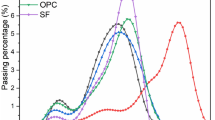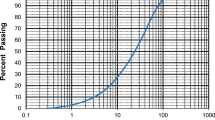Summary
In the mining industry today there is some caution about using fine tailings as a backfill material. Traditionally, hydraulic backfill has only used the coarse fraction of tailings, excluding the fines by a classification process. With the development of paste fill, the percentage of fine tailings being sent underground has increased, but still remains low due to the high percentages of sand and gravel which usually make up these fills. Sand and gravel have been added to paste fills to aid pumpability and to increase fill strength and stiffness. This leaves the remainder of fine tailings destined for surface disposal. The main focus of this paper is to evaluate what effect the addition of fine gold mill tailings in the form of agglomerated tailings pellets has on the strength and stiffness characteristics of a total tailings paste fill. The purpose is to create a high modulus fill which is made up entirely of fine tailings. A constant slump design of 20 cm (8 in) was used for each mix. Various binder dosages, curing periods and combinations of pellet to tailings ratio were studied. Raw fill slump and density, and cured fill compressive strength and modulus of elasticity were also examined. Results from the above study indicate that agglomerated tailings paste fill (ATPF) has superior strength and stiffness characteristics. Compressive strengths were enhanced while the modulus of elasticity values was tripled when compared to total tailings paste fills of the same binder content and consistency. ATPF minimizes the surface disposal of tailings and maximizes the utilization of fine tailings underground as a useful backfill material.
Similar content being viewed by others
References
Amaratunga, L.M. and Annor, A. (1989) A concept of agglomeration of fine mill tailings for backfill and preliminary experimental studies, inTailings and Effluent Management, Canadian Institute of Mining and Metallurgy, Chalkley M.E.et al. eds, Pergamon Press, New York. pp. 229–38.
Amaratunga, L.M. (1992) Total tailings recovery for mine backfill,URIF/Lac Minerals Ltd./Lafarge Canada Inc. Final Report, Vols 1, pp. 63.
Amaratunga, L.M. (1996) Agglomeration of tailings for backfill and its environmental benefits,EYC-MNDM Report, May 1996, p. 75.
ASTM (1995) ASTM C143: Test Method for Slump of Portland Cement Concrete. American Society for Testing and Materials.
ASTM (1995) ASTM C192: Method of Making and Curing Concrete Test Specimens in the Laboratory. American Society for Testing and Materials.
Brackebusch, F.W. (1994) Basics of paste backfill systems,Mining Engineering,46, 1175–8.
Brummer, R. and Moss, A. (1991) Paste: the fill of the future? (Part I),Canadian Mining Journal,112, 31–5.
Brummer, R., Aref, K. and Moss, A. (1992) Paste: the fill of the future? (Part II),Canadian Mining Journal,113, 39–43.
Capes, C.E. (1971) The correlation of agglomerate strength with size.Powder Technology,5, pp. 119–125.
CSA. Standard A23. 2-5C. Canadian Standards Association.
Kosmatka, S. Panarese, W., Allen, G. and Cumming, S. (1991)Design and Control of Concrete Mixtures, 5th edn. Canadian Portland Cement Association, Ottawa, p. 40.
Lamos, A.W. (1993) An assessment of the effects of ultrafine aggregate components on the properties of mine backfills, inMinefill 93, South Africa Institute of Mining and Metallurgy, Johannesburg, pp. 173–9.
Landriault, D. (1992) INCO's backfill experience,Canadian Mining Journal,113, 39–46.
Lidkea, W. and Landriault, D. (1993) Tests on paste fill at INCO, inMinefill 93, South Africa Institute of Mining and Metallurgy, Johannesburg, pp. 337–47.
Manca, P.P., Massaci, G., Massidda, L. and Rossi, G. (1983) Mill tailings and analysis of properties related to mining problems, inProceedings of the International Symposium on Mining with Backfill, Granholm S., Lulea, A.A., Balkema Publishers, Rotterdam. pp. 39–47.
Swan, G. (1985) A new approach to cemented backfill design,CIM Bulletin, December,78, 884, 53–58.
Udd, J.E. (1989) Backfill research in Canadian mines, inInnovations in Mining Backfill Technology, Hassani, F.P. ed., Montreal, pp. 3–13.
Verkerk, C.G. and Marcus, R.D. (1988) The pumping characteristics and rheology of paste fills, inBackfill in South African Mines, South African Institute of Mining and Metallurgy, Johannesburg, pp. 221–33.
Viles, R.F. and Davis, R.T.H. (1989) New materials technologies applied in mining with backfill, inInnovations in Mining Backfill Technology, Hassani, F.P. eds, Montreal, Balkema Publishers, Rotterdam. pp. 95–101.
Whiteway, P. (1995) Paste fill,A Special Commemorative Supplement to the Canadian Mining Journal, April, 27–8.
Author information
Authors and Affiliations
Rights and permissions
About this article
Cite this article
Amaratunga, L.M., Yaschyshyn, D.N. Development of a high modulus paste fill using fine gold mill tailings. Geotech Geol Eng 15, 205–219 (1997). https://doi.org/10.1007/BF00880825
Received:
Accepted:
Issue Date:
DOI: https://doi.org/10.1007/BF00880825




